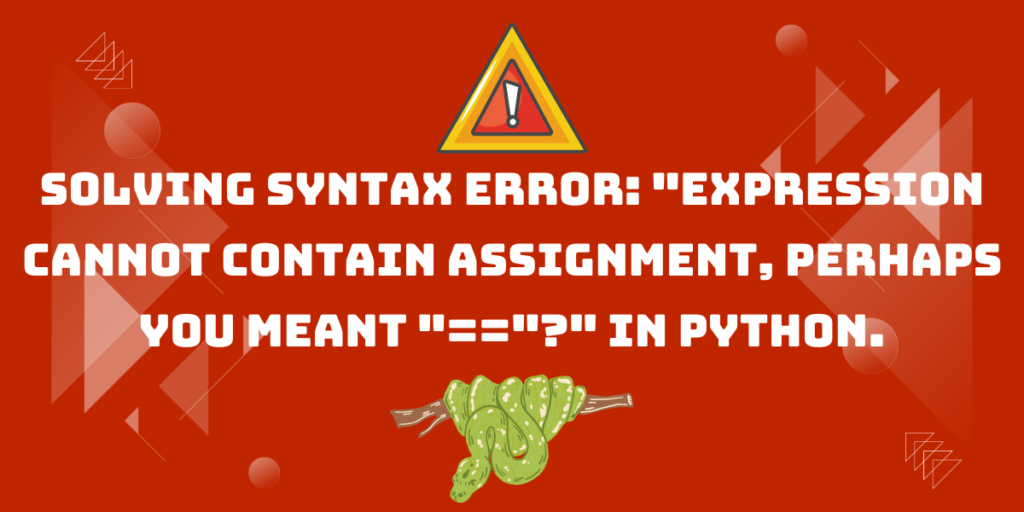In Python, there are three main types of errors: Syntax errors, Runtime errors, and Logical errors. Syntax errors can include system errors and name errors. System errors occur when the interpreter encounters extraneous tabs and spaces, given that proper indentation is essential for separating blocks of code in Python. Name errors arise when variables are misspelled, and the interpreter can’t find the specified variable within the code’s scope.
Syntax errors are raised when the Python interpreter fails to understand the given commands by the programmer. In other words, when you make any spelling mistake or typos in your code, it will most definitely raise a syntax error.
It can also be raised when defining data types. For example, if you miss the last curly bracket, “}” when defining a dictionary or capitalize the “P” while trying to print an output, it will inevitably raise a syntax error or an exception.
In this article, we will take a look at one of the most common syntax errors. When trying to define dictionaries, there shouldn’t be any assignment operator, i.e., “=” between keys and values. Instead, you should put a colon , “:” between the two.
Let’s look at the root of the above problem followed by it’s solution.
Similar: Syntax Error: EOL while scanning string literal.
Causes of Syntax Errors in Python Dictionaries
Python’s syntax errors can happen for many reasons, like using tabs and spaces incorrectly, spelling variables wrong, using operators the wrong way, or declaring things incorrectly. One common mistake is defining dictionaries wrongly by using “=” instead of “:” between keys and values. Fixing these issues usually means double-checking that everything is spelled right and that you are using things like colons, semicolons, and underscores properly.
There can be numerous reasons why you might encounter a syntax error in python. Some of them are:
- When a keyword is misspelled.
- If there are missing parenthesis when using functions, print statements, or when colons are missing at the end of for or while loops and other characters such as missing underscores(__) from def __innit__() functions.
- Wrong operators that might be present at the wrong place.
- When the variable declared is wrong or misspelled.
Differentiating between ‘=’ and ‘==’ in context of Python Dictionaries
In Python and many other programming languages, the single equals sign “=” denotes assignment, where a variable is given a specific value. In contrast, the double equals sign “==” is used to check for equality between two values or variables.
For example, if there are two variables, namely. ‘a’ and ‘b’ in your code, and you want to assign the integer values of 10 and 20 to each, respectively. In this case, you’ll need to use the assignment operator, that is, a single equal to sign(=) in your code in the following way:
a,b=10,20
But instead, if we want to check whether the values assigned to ‘a’ and ‘b’ are equal using an “if” statement, we will use the double equal to sign (==) such as,
if(a==b):
Syntax Rules for Python Dictionaries
In Python, dictionaries are a unique type of data-storing variables. They are ordered and mutable in nature unlike lists. They are assigned in pairs, in the form of keys and values. Each element in a dictionary is indexed by its’ keys. Each value is accessed by keeping track of its respective key. There should be a colon”:” separating the value from its respective key. They are represented by curly braces ‘{}’. Each key and value pair can be separated from one another with commas ‘,’.
They can be assigned in the following manner:
our_dictionary= {"key1": "value1",
"key2":"value2",
"key3":"value3",....}
Do check out: [SOLVED] ‘Unexpected Keyword Argument’ TypeError in Python.
Reproducing the Syntax Error: expression cannot contain assignment, perhaps you meant “==”?
In this case, the problem might arise when instead of using a colon “:”, the interpreter encounters an assignment operator. There is a built in function in Python that can explicitly convert data into dictionaries called dict(). But this function might also cause this problem when the identifier is wrong or when there are other syntax mistakes in the code, such as missing parenthesis at the end of a statement.
The error is shown below:

Mitigating Syntax Errors in Python Dictionaries
The only straight forward solution to this problem is making sure you spell the keywords and in built functions correctly and remember to use the identifiers such as colons, semicolons and underscores properly.
Try to avoid using the dict() function for creating dictionaries. Instead, use curly braces as much as possible. If using the function is a necessity, make sure you don’t use the assignment operator incorrectly and use parentheses where necessary.
In the following code, there are no exceptions raised because the syntax is correct and the variable has been assigned correctly.
our_dict = {1:'a', 2:'b', 3:'c', 4:'d'}
Nowadays, there are built in syntax detectors in IDEs and editors which can highlight syntax errors like this one. You can also use a debugger if necessary.
Key Takeaways: Avoiding Syntax Errors in Python Dictionaries
Having dived into the causes and solutions of Python’s syntax errors, we hope this equips you to write more efficient, error-free code. The intricacies of Python dictionaries need not be a source of worry. With the right practices, you can avoid these errors, optimizing your code and enriching your programming journey.
How will this knowledge influence your approach to using Python dictionaries in future projects?
